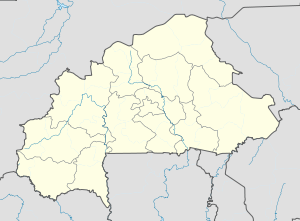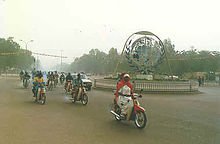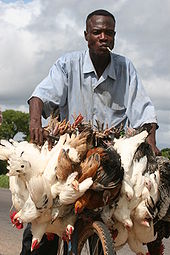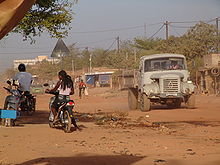- Ouagadougou
-
Ouagadougou Nickname(s): Ouaga Location within Burkina Faso Coordinates: 12°21′26″N 1°32′7″W / 12.35722°N 1.53528°WCoordinates: 12°21′26″N 1°32′7″W / 12.35722°N 1.53528°W Country  Burkina Faso
Burkina FasoRegion Centre Region Province Kadiogo Government – Mayor Simon Compaoré (since 1995) Area – City 84.7 sq mi (219.3 km2) – Metro 1,083 sq mi (2,805 km2) Elevation 1,001 ft (305 m) Population (2006-Dec-09) – City 1,475,223 – Density 17,422.9/sq mi (6,727/km2) – Metro 1,727,390 Website http://www.mairie-ouaga.bf Ouagadougou (
 /ˌwɑːɡəˈduːɡuː/; Mossi: [ˈwaɡᵊdᵊɡᵊ]) is the capital of Burkina Faso and the administrative, communications, cultural and economic center of the nation. It is also the country's largest city, with a population of 1,475,223 (as of 2006).[1] The city's name is often shortened to Ouaga. The inhabitants are called ouagalais. The spelling of the name Ouagadougou is derived from the French orthography common in former French African colonies. If English orthography were used (as in Ghana or Nigeria), the spelling would be Wagadugu.[2]
/ˌwɑːɡəˈduːɡuː/; Mossi: [ˈwaɡᵊdᵊɡᵊ]) is the capital of Burkina Faso and the administrative, communications, cultural and economic center of the nation. It is also the country's largest city, with a population of 1,475,223 (as of 2006).[1] The city's name is often shortened to Ouaga. The inhabitants are called ouagalais. The spelling of the name Ouagadougou is derived from the French orthography common in former French African colonies. If English orthography were used (as in Ghana or Nigeria), the spelling would be Wagadugu.[2]Ouagadougou's primary industries are food processing and textiles. It is served by an international airport, rail links to Abidjan in Côte d'Ivoire and to Kaya in the north of Burkina, and a highway to Niamey, Niger. Ouagadougou was the site of Ouagadougou grand market, one of the largest markets in West Africa, which burned in 2003 and remains closed. Other attractions include the National Museum of Burkina Faso, the Moro-Naba Palace (site of the Moro-Naba Ceremony), the National Museum of Music, and several craft markets.
Contents
History
The name Ouagadougou dates back to the 15th century when the Ninsi tribes inhabited the area. They were in constant conflict until 1441 when Wubri, a Yonyonse hero and an important figure in Burkina Faso's history, led his tribe to victory. He then renamed the area from "Kumbee-Tenga", as the Ninsi had called it, to "Wogodogo", meaning "where people get honor and respect". Ouagadougou is a Francophone of Wogodogo.
The city became the capital of the Mossi Empire in 1441 and was the permanent residence of the Mossi emperors (Moro-Naba) from 1681.[3] The Moro-Naba Ceremony is still performed every Friday by the Moro-Naba and his court. The French made Ouagadougou the capital of the Upper Volta territory (basically the same area as contemporary independent Burkina Faso) in 1919. In 1954 the railroad line from Cote d'Ivoire reached the city. The population of Ouagadougou doubled from 1954 to 1960 and has been doubling since about every ten years.[3]
Geography
Ouagadougou, situated on the central plateau (12.4° N 1.5° W), grew around the imperial palace of the Mogho Naaba. Being an administrative center of colonial rule, it became an important urban center in the post-colonial era. First the capital of the Mossi Kingdoms and later of Upper Volta and Burkina Faso, Ouagadougou became a veritable communal center in 1995.
Government
The first municipal elections were held in 1956.
Ouagadougou is governed by a mayor, who is elected for a five-year term, two senior councillors, and 90 councillors.
The city is divided into five arrondissements, consisting of 30 sectors, which are subdivided into districts. Districts of Ouagadougou include Gounghin, Kamsaoghin, Koulouba, Moemmin, Niogsin, Paspanga, Peuloghin, Bilbalogho, and Tiendpalogo. Seventeen villages comprise the Ouagadougou metropolitan area, which is about 219.3 km².
The population of this area is estimated to be 1,475,000 inhabitants, 48% of which are men and 52% women. The rural population is about 5% and the urban population about 95% of the total, and the density is 6,727 inhabitants per square kilometer, according to 2006 census.
Concerning city management, the communes of Ouagadougou have made the decision to invest in huge projects. This is largely because Ouagadougou constitutes a 'cultural centre' by merit of holding the SIAO (International Arts and Crafts fair) and the FESPACO (Panafrican Film and Television Festival of Ouagadougou). Moreover, the growing affluence of the villages allow for such investment, and the fact that the population is growing rapidly necessitates it.[2]
The Arrondissements of Ouagadougou Arrondissement Population (Census 2006)[1] Baskuy 180,512 Bogodogo 374,473 Boulmiougou 366,182 Nongremassom 188,329 Sig-Noghin 163,859 Climate
The climate of Ouagadougou is hot. Under the Köppen climate classification the city features a tropical savanna climate. The city is part of the Soudano-Sahelian area, with a rainfall of about 900 mm (35 in) per year. The rainy season stretches from May to October, with an average temperature of 30 °C (86 °F). The cold season runs from December to January, with a minimum temperature of 19 °C (66 °F). The maximum temperature during the hot season, which runs from March to May, can reach 45 °C (113 °F). The harmattan (a dry wind) and the monsoon are the two main factors that determine Ouagadougou's climate.
Climate data for Ouagadougou Month Jan Feb Mar Apr May Jun Jul Aug Sep Oct Nov Dec Year Record high °C (°F) 45
(113)45
(113)45
(113)47
(117)48
(118)44
(111)41
(106)38
(100)39
(102)41
(106)42
(108)45
(113)48
(118)Average high °C (°F) 33
(91)37
(99)40
(104)39
(102)38
(100)36
(97)33
(91)31
(88)32
(90)35
(95)36
(97)35
(95)35.4
(95.8)Average low °C (°F) 16
(61)20
(68)23
(73)26
(79)26
(79)24
(75)23
(73)22
(72)23
(73)23
(73)22
(72)17
(63)22.1
(71.7)Record low °C (°F) 9
(48)12
(54)15
(59)15
(59)19
(66)17
(63)18
(64)14
(57)19
(66)18
(64)16
(61)11
(52)9
(48)Precipitation mm (inches) 0
(0)3
(0.12)13
(0.51)15
(0.59)84
(3.31)122
(4.8)203
(7.99)277
(10.91)145
(5.71)33
(1.3)0
(0)0
(0)895
(35.24)Source: BBC Weather [4] Tourism
Parks
The Bangr-Weoogo urban park (area: 2.63 km2 (1 sq mi)), before colonialism, belonged to the Mosse chiefs. Considering it a sacred forest, many went there for traditional initiations or for refuge. The French colonists, disregarding its local significance and history, established it as a park in the 1930s. In 1985, renovations were done in the park. In January 2001, the park was renamed "Parc Urbain Bangr-Weoogo", meaning "the urban park of the forest of knowledge".
Another notable park in Ouagadougou is the "L'Unité Pédagogique", which shelters animals in a semi-free state. This botanic garden/biosphere system stretches over 8 hectares (20 acres) and also serves as a museum for the country's history.
"Jardin de l'amitié Ouaga-Loudun" (Garden of Ouaga-Loudun Friendship), with a green space that was renovated in 1996, is a symbol of the twin-city relationship between Ouagadougou and Loudun in France. It is situated in the center of the city, near the "Nation Unies' crossroads".
Other sites
"Naba Koom" is a statue depicting a woman handling a calabash to pour water. The 6-metre (20 ft) high statue faces the railway station, welcoming travellers into Ouaga. The place bears the name of an important chief in Burkina Faso’s history.
"Laongo", 30 km (19 mi) east of the city, features enormous granite slabs that were designed by various sculptors. The exhibit displays works of art from five continents.[2]
"La Place du Grand Lyon" is a monument that reflects the relationship between Burkina Faso's capital and Lyon in France. It is located near the French cultural Center George Melies and features an imposing lion. A zoo called "Parc Animalier de Ziniaré" is located 30 km (19 mi) east of the city in the hometown of the president.
- National Museum of Music: exhibits all the musical instruments of Burkina Faso.
- Musée de Manega: also exhibits musical instruments of Burkina Faso, Mossi rifles and other cultural items. Located 55 km (34 mi) northwest of the city
Sights of Ouagadougou
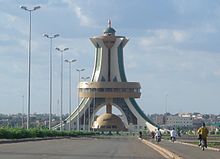 Memorial To The Martyrs[5]
Memorial To The Martyrs[5]
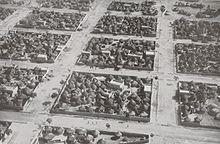 Ouagadougou in late December 1930 or early January 1931. Air photo taken by Swiss pilot and photographer Walter Mittelholzer.
Ouagadougou in late December 1930 or early January 1931. Air photo taken by Swiss pilot and photographer Walter Mittelholzer.
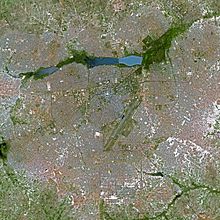 Ouagadougou seen from SPOT Satellite.
Ouagadougou seen from SPOT Satellite.
Social life and education
Education
Though literacy in Ouagadougou is not high, there are two universities in the city. The largest college is the state University of Ouagadougou which was founded in 1974. The official language in the city is French and the principal local languages are More, Dyula and Fulfulde. The bilingual program in schools (French plus one of the local languages) was established in 1994.[2]
Sport, culture, and leisure
A wide array of sports, including association football, basketball, and volleyball, is played by Ouagadougou inhabitants. There are sports tournaments and activities organized by the local authorities.
There are a number of cultural and art venues, such as the Maison du Peuple and Salle des Banquets, in addition to performances of many genres of music, including traditional folk music, modern music, and rap.[2]
Art and crafts
Several international festivals and activities are organized within the municipality, such as FESPACO (Panafrican Film and Television Festival of Ouagadougou), which is Africa's largest festival of this type, SIAO (International Art and Craft Fair), FESPAM (Pan-African Music Festival), FITMO (International Theatre and Marionnette Festival) and FESTIVO.[2][6]
Health
Ouagadougou has both state and private hospitals. The two state hospitals in the city are the Centre hospitalier national Yalgado Ouedraogo (CHNYO) and the Centre hospitalier national pédiatrique Charles de Gaulle (CHNP-CDG), but there are also private hospitals. Despite that, the local population still largely trusts traditional local medicine and the "pharmacopée".[2]
Transport
Many residents travel on motorcycles and mopeds. The large private vendor of motorcycles JC Megamonde sells 50,000 motorbikes and mopeds every year.[3]
Ouagadougou's citizens also travel in green cabs, which take their passengers anywhere in town for 200 to 400 CFA, but the price is higher after 10:00 p.m. and can then reach 1000CFA.[citation needed]
Ouagadougou Airport (code OUA) serves the area with flights to West Africa and Europe. Air Burkina has its head office in the Air Burkina Storey Building (French: Immeuble Air Burkina) in Ouagadougou.[7][8]
Ouagadougou is connected by rail to Côte d'Ivoire and to Kaya in the north of Burkina Faso. See Rail transport in Burkina Faso.
International relations
Twin towns — Sister cities
References
- ^ a b National 2006 census final results[dead link]
- ^ a b c d e f g Commune Ouagadougou (2005). Mairie de Ouagadougou. Retrieved March 19, 2006 from Mairie de Ouagadougou (French)
- ^ a b c "French Wikipedia page". http://fr.wikipedia.org/wiki/Ouagadougou. Retrieved 2010-07-13.
- ^ "Average Conditions Ouagadougou". BBC Weather.
- ^ "This is africa". http://fyeahafrica.tumblr.com/post/2402210583/naijagirl-the-africa-they-never-show-you. Retrieved August 12, 2011.
- ^ La Girafe (2004). Ouaga-ca-bouge. Retrieved March 19, 2006 from Ouagadougou au Burkina Faso (French)
- ^ "Contact-us". Air Burkina. Retrieved on 19 October 2009.
- ^ "Contactez-nous." Air Burkina. Retrieved on 19 October 2009.
- ^ "Partner Cities of Lyon and Greater Lyon". © 2008 Mairie de Lyon. http://www.lyon.fr/vdl/sections/en/villes_partenaires/villes_partenaires_2/?aIndex=1. Retrieved 2009-07-17.
- ^ Ouagadougou and Taipei establish sister cities link[dead link]
- ^ Sister city list (.DOC)
External links
- Ouagadougou Official site of the government of Ouagadougou
- The plan of Ouagdougou
- Falling Rain Genomics: World Index, and other pages
- Ouagadougou travel guide from Wikitravel
- Burkina-Faso: Le plan de Ouagadougou.(2004). Le plan de Ouagadougou(Burkina-Faso)
Capitals of Africa Abuja, Nigeria
Accra, Ghana
Addis Ababa, Ethiopia
Algiers, Algeria
Antananarivo, Madagascar
Asmara, Eritrea
Bamako, Mali
Bangui, Central African Republic
Banjul, Gambia
Bissau, Guinea-Bissau
Bloemfontein, South Africa 1
Brazzaville, Rep. of the Congo
Bujumbura, Burundi
Cairo, Egypt
Cape Town, South Africa 2
Conakry, GuineaPort Louis, Mauritius
Porto-Novo, Benin
Praia, Cape Verde
Pretoria, South Africa 3
Rabat, Morocco
Saint-Denis, Réunion
São Tomé, São Tomé and Príncipe
Tripoli, Libya
Tunis, Tunisia
Victoria, Seychelles
Windhoek, Namibia
Yaoundé, Cameroon
Yamoussoukro, Côte d'Ivoire1 Judicial. 2 Parliamentary. 3 Executive. 4 An unrecognised or partially-recognised state.Categories:- Ouagadougou
- Capitals in Africa
- French West Africa
- Populated places in the Centre Region
Wikimedia Foundation. 2010.


